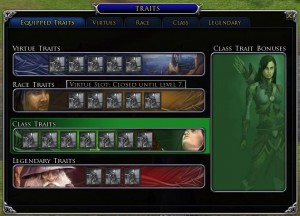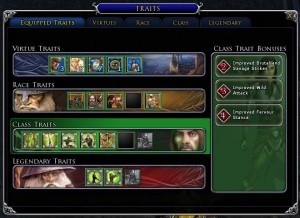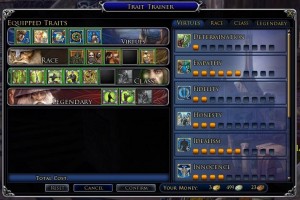I tend to write blog posts for a few reasons, maybe I just have something in my head I want to get out, or I feel like ‘talking’ or because I want to write something I hope might be useful. This post falls into that last category. Here then, is a long blog post probably broken up into multiple parts, on the Traits system within the Lord of the Rings online game. It won’t be the most comprehensive guide to Traits, but I hope it’ll be a useful introduction to the different elements and how they fit together.
Introduction
Most roleplaying games have a number of elements which combine together to give your character their shape. Often, there is an overall level which provides a rough power indicator for your character, then some skills which define what you can do and usually some attributes (like strength or agility). Beyond that, games differ greatly on how they let you fine tune your particular character, and in online games, that fine tuning is often something that involves the most effort for the least overall reward. Despite the small returns, those little tweaks are what make your Warrior different from some other Warrior. Yours might have a quicker thrust, or a faster retreat option, while theirs might have a stronger arm or more solid shield.
In Lord of the Rings Online that customisation is provided by the Traits system. Traits affect your character attributes and skills in a multitude of different ways. Traits might provide more morale, faster power regeneration, they might extend the time a skill works for, give you more resistance to fire based attacks, or even provide entirely new skills alltogether. Two Hunter characters might fair very differently in the same fight based on their trait choices. There are four types of traits, lots of different traits in each type, completely different traits for each class and race, and a large number of ways they can be earned. You could spend weeks reviewing all the options and how they affect a specific character. For the most part, average players don’t spend that much time on them, but as you reach higher levels there usually comes a moment where you wonder why someone else survived a fight you didn’t and often the answer is trait choice.
Here then is my description of Traits, how they’re earned, why they’re called Virtues and why Deeds are so important. Part one will be a general overview of the system.
Types
There are four types of trait. The different types tend for the most part to be earned in different ways, although there is some overlap. In the section below I’ll provide a basic overview of each type and how they are most commonly earned. Subsequent posts will go into more detail on each of the different types.
Virtues (can be equipped from level 7)
Virtues are the most basic trait, and your character starts earning these almost as soon as they start adventuring. Each virtue provides three benefits to your character in the form of improvements to their attributes. The range of attributes is diverse and includes basic stats such as Agility, defences such as Fire, improvements to in-combat power regeneration, and a large list of other possible benefits. Nearly all virtues are earned as the rewards for common deeds. They tend to be location based deeds such as killing orcs in The Lonelands or scouting ancient ruins in the North Downs.
Virtues are unique among the other types of traits in that additional instances of the same virtue stack together. For example, you may earn your first Charity virtue by completing a deed in The Shire. You could then equip it, and it would be at rank 1. If you later earned another Charity virtue, perhaps in the Lonelands, it would automatically increase your equipped Charity trait to rank 2, and the benefits provided by the virtue would increase. It does not matter where you earn your first rank of a virtue, nor what level you are when you do it. The maximum rank any virtue may rise to is currently 10. Earning multiple ranks in virtues is one of the ways to greatly increase your character’s power.
Virtues are identical for all classes and races in both name and benefit provided.
Racial (can be equipped from level 13)
Racial traits are, as the name suggests, unique to each race in both the effect they provide and the activity required to earn them. They are mostly earned by killing enemies considered to be racial enemies. For example, Dwarves have great enmity towards the Dourhands, Elves towards drakes, Hobbits towards wolves and Men towards the dead. They tend to provide new skills or unique bonuses as rewards. They are level restricted such that you may not see the deed required to earn the trait until you reach a certain level, at which point killing one of the enemies in question will give you the new deed.
Class (can be equipped from level 15)
Class traits are most often earned by repeatedly using class based skills. The traits and their benefits are different for every class. These traits provide the most significant customisation of the classes. In the Mines of Moria expansion class traits were modified so that for each class they now fall into three groups. Each group or set gives a particular class focus, and they achieve this because collecting traits within the same set/group provides additional benefits. For example, you might choose to play a Guardian and focus on two-handed weapon / overpower traits, or you may prefer to generate more hate. Choosing traits that match those rolls will provide additional benefits that complement that style. That will be covered in more detail in a later post. It is worth noting that this system is optional, you are free to equip any combination of class traits you like.
Legendary (can be equipped from level 41)
The last class of trait and the least numerous are Legendary traits. As the name suggests (at least in theory) these traits provide your character with legendary abilities that define their place in the War of Middle Earth. In practice some people find the benefits vary in quality on a per trait basis. Each class gets a totally unique set of Legendary traits. They are earned in different ways, either through collection deeds, earning reputation and purchasing books, or completing quest lines. The only common factor is that at each stage, each class has to complete the same type of activity to earn similar legendary traits. For example, in the mid 40’s the first three legendary traits are all earned by collecting a book and then 8 missing pages. Each class requires different books and pages, and gets different traits, but they are all earned in the same way.
Viewing Traits
Traits can be examined using the trait window (by default, this is opened by pressing J). The trait window has 5 tabs along the top, the first shows all equipped traits, the second lists virtues, the third lists race traits, then class traits and the final tab lists legendary traits. The window changed in the Mines of Moria expansion, and the final four tabs now show all the possible traits your character may earn, and which ones you have completed. Here’s how the window looks as a starting character (for all images in this series of blog posts, you may click for a larger picture).
And for comparison, here’s the same window from a level 53 Champion,
Later articles will go into more detail on each of the tabs and what the dialog is actually showing you.
Equipping / Changing Traits
Equipping traits you have earned or changing your existing trait line-up requires a visit to a Bard. They’re placed throughout Middle Earth and nearly every town or city has one. Visiting the bard will turn off any active skills you have on, and will present you with a dialog that looks like this.
Using that dialog you can remove or add traits to your line-up and see what the total cost will be, as well as see which traits you already have equipped. Traits can be changed at will and the only downside to doing so is the cash cost, which can get quite high. Some players have combinations of traits they equip for different roles (maybe soloing, or grouped, or raiding, or fighting creatures with high Shadow damage, etc.) Doing so might be useful but it’s also costly, and the people I play the game with don’t tend to bother. They find a combination of traits which gives them an overall decent character and then tend to stick with it. It might get changed if a specific encounter is giving a specific issue, but in general, it stays reasonably constant.
Summary
Traits provide a mechanism for customising your character in Lord of the Rings online. They offer a huge range of variations for each character, and are the most complex part of defining your avatar. They are split into four types, virtues, class, race and legendary. They are earned in a myriad of different ways (although nearly all of them rely on deeds to track progress). In the next article I’ll provide a refresher on deeds, what they are, how they are started and how they are tracked. Traits rely heavily on the deed system in Lord of the Rings online so you need to have a good grounding in how that works, before you can progress.




An excellent read. I thought that now I’ve been playing the game for a couple of months I’d start to learn about these (my character level is 27).
Thanks for writing them.
Hi Tony – great work, ive been playing LOTRs for two years and ive just got to grips with these mechanics – this will be a great help to new players – nice work fella